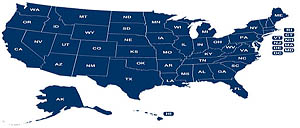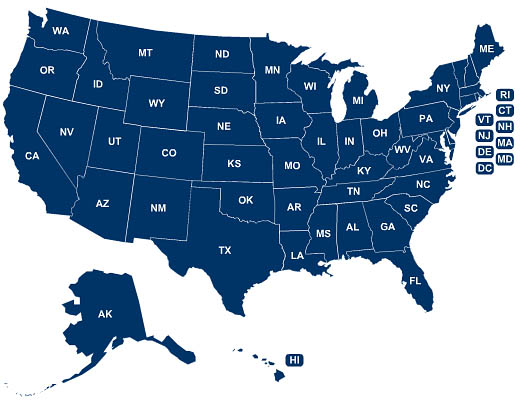Lowest to Highest Taxes by State


Wondering which U.S. State may be better to live in regarding their taxes and tax burden? While we cannot escape taxes, we can make decisions which will minimize our overall State tax burden, depending on each of our own financial situations and objectives.
In this article, we will address property tax, income tax, and sales tax.
Let’s say you are planning to retire, and/or move out of your State. Among the many things that you will consider in your selection process may be picking a tax friendlier region.
The debt burden of many cities, counties, states, and the federal government are being stressed. There is little doubt that taxes, including State taxes will be on the increase as governments look for more revenue.
Regarding the three primary sources of revenue from State taxes (income, sales, property), your own personal situation and preferences will ‘weight’ each of these differently. For example, if you are retired or soon to retire, the income tax of a given State may be less important to you than say, the property tax of the county or town since your income may be relatively low (retirement). However your property taxes will always be there and will continue to rise over time.
Here are a few State tax statistics from a number of sources including RetirementLiving.com, Wikipedia, Census.gov/govs/statetax, State Government Tax Collections 2009, and the TaxFoundation.org.
How to Make Your Money Last: The Indispensable Retirement Guide
State Sales Tax
Except for very expensive (or lots of) annual purchases, State sales tax might be less important to your overall tax burden when compared to property taxes and income taxes. For example, in 1-year you would have to purchase more than $40,000 of taxable products taxed at a 7% sales tax to be equivalent to the impact of an annual $3,000 property tax bill.
This sales tax list includes the base rate plus the maximum local surtax that may exist in that State. This surtax is typically only on certain goods and may slightly skew some State results – but I wanted to include a worst-case scenario.
Your sales tax rates may be lower if you’re living outside of the surtaxed area or not purchasing a surtaxed product.
Rates are rounded to the nearest 0.1 decimal.
List of State Sales Tax including any local surtax
Delaware (0%)
New Hampshire (0%)
Oregon (0%)
Montana (3%) general sales tax = 0%, a few surtaxes apply at 3%
Hawaii (4.7%)
Maine (5%)
North Dakota (5%)
Virginia (5%)
Wisconsin (5.6%)
Arkansas (6%)
Connecticut (6%)
D.C. (6.0%)
Idaho (6%)
Kentucky (6%)
Maryland (6%)
Michigan (6%)
South Dakota (6%)
West Virginia (6%)
Massachusetts (6.3%)
Alaska (7%)
Iowa (7%)
Nebraska (7%)
New Jersey (7%)
Rhode Island (7%)
Vermont (7%)
Wyoming (7%)
Florida (7.5%)
Ohio (7.8%)
Minnesota (7.8%)
Colorado (8.0%)
Georgia (8%)
Pennsylvania (8%)
Nevada (8.1%)
North Carolina (8.3%)
Texas (8.3%)
Utah (8.4%)
Oklahoma (8.5%)
New Mexico (8.6%)
Kansas (8.7%)
New York (8.9%)
Indiana (9%)
Louisiana (9%)
Mississippi (9%)
South Carolina (9%)
Missouri (9.2%)
Washington (9.5%)
Tennessee (9.8%)
Alabama (10%)
Arizona (10.6%)
California (10.8%)
Illinois (11.5%)
State Personal Income Tax
A total of 41 States impose income taxes. Some States base their income tax on federal returns, typically taking a percentage of your federally adjusted gross income.
States with No Income Tax
Alaska
Florida
Nevada
South Dakota
Texas
Washington
Wyoming
New Hampshire (except tax on income from interest and dividends)
Tennessee (except tax on income from interest and dividends)
State Income Tax rates based on $60,000 income
Unless you earn very little, or earn substantially more than $60K, the following State income tax rates probably fit most of the typical folks out there, and will give you an idea of where the states ranked in 2010. Rates are rounded to the nearest 0.1 decimal, and do not include any special deductions or exemptions that may exist.
State (income tax %)
Alaska (0%)
Florida (0%)
Nevada (0%)
New Hampshire (0%) except tax on income from interest and dividends
South Dakota (0%)
Tennessee (0%) except tax on income from interest and dividends
Texas (0%)
Washington (0%)
Wyoming (0% )
Illinois (3%)
Pennsylvania (3%)
Indiana (3.4%)
North Dakota (3.8%)
Michigan (4.4%)
Arizona (4.5%)
Colorado (4.6%)
Ohio (4.7%)
New Mexico (4.9%)
Alabama (5%)
Connecticut (5%)
Maryland (5%)
Mississippi (5%)
Utah (5%)
Massachusetts (5.3%)
Oklahoma (5.5%)
Kentucky (5.8%)
Virginia (5.8%)
Georgia (6%)
Louisiana (6% )
Missouri (6%)
New Jersey (6.4%)
Kansas (6.5%)
West Virginia (6.5% )
Wisconsin (6.8%)
Nebraska (6.8%)
Maine (6.9%)
Montana (6.9%)
Delaware (7%)
Arkansas (7% )
North Carolina (7%)
South Carolina (7%)
Rhode Island (7.8%)
Idaho (7.8%)
Minnesota ( 7.9%)
New York (7.9%)
Hawaii (8.3%)
Vermont (8.3%)
D.C. ( 8.5%)
Iowa (9%)
California (9.6%)
Oregon (10.8%)
Places Rated Almanac (Best Places To Live)
State Property Tax
The largest source of revenue for local governments are taxes on land and the buildings built on it.
Property taxes are not imposed by the States, but by the tens of thousands of cities, townships, counties, school districts and other assessing jurisdictions.
You cannot escape property taxes in any state. But you can find significantly low rates in certain parts of the country.
Having sorted through a list of home property taxes, listed by median price per county, and then averaging the property taxes of all combined counties in each state, the following list of home property taxes by State should give you a general indication. For finer detail, each individual county would need to be checked because property taxes can vary substantially based on region and the home’s assessed value itself.
Data from 2009 (although surely very close to what it is today)
Home Property Tax average per State
State ($ avg. per home)
Louisiana ($404)
Alabama ($410)
West Virginia ($615)
Arkansas ($684)
South Carolina ($693)
Mississippi ($787)
New Mexico ($862)
Delaware ($950)
Oklahoma ($968)
Arizona ($986)
Tennessee ($1,041)
Hawaii ($1,047)
Kentucky ($1,059)
Wyoming ($1,084)
Indiana ($1,104)
North Carolina ($1,172)
Idaho ($1,213)
Utah ($1,305)
Georgia ($1,377)
Missouri ($1,443)
Colorado ($1,538)
Florida ($1,619)
Montana ($1,764)
Ohio ($1,834)
Nevada ($1,879)
Iowa ($1,934)
Kansas ($1,957)
Maine ($1,976)
Oregon ($2,045)
D.C. ( $2,057)
Michigan ($2,069)
South Dakota ($2,076)
Pennsylvania ($2,092)
Washington ($2,127)
Texas ($2,141)
Virginia ($2,230)
Minnesota ($2,340)
California ($2,631)
Maryland ($2,637)
North Dakota ($2,638)
Alaska ($2,796)
Nebraska ($2,829)
Wisconsin ($3,041)
Massachusetts ($3,255)
Illinois ($3,272)
Rhode Island ($3,731)
New York ($3,736)
Vermont ($4,168)
Connecticut ($4,437)
New Hampshire ($4,618)
New Jersey ($6,348)
UPDATE (2017)
Property Taxes – Lowest to Highest by State sorted by dollars
There are many factors that go into one’s formula to decide the best place to retire, or the best place to move to, because we each have our own individual notions of what that is.
However, near the top of the list of factors or concerns should be property tax, income tax, and sales tax. Also, nearly just as important, do not forget to research the fiscal situation of the state, city, or town that you are contemplating moving to. There are many of these that are themselves on the verge of bankruptcy. They will be the first to raise your taxes.
Related Article:
State Tax Burden
State Income Tax Comparison

Cities Ranked & Rated (2nd Edition): More than 400 Metropolitan Areas Evaluated
